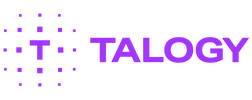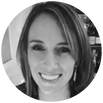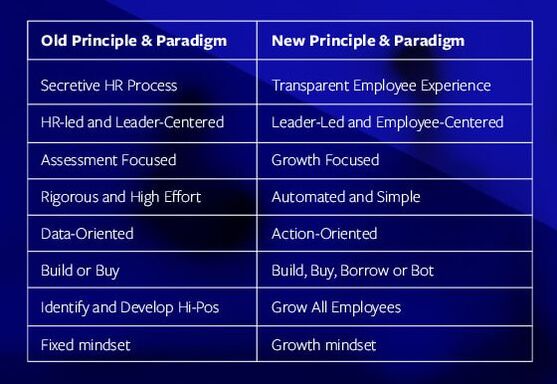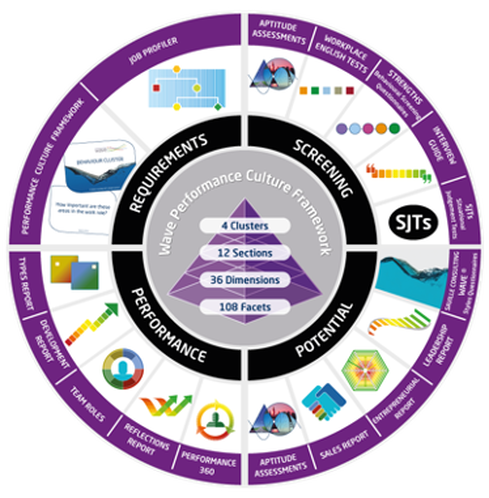From Integrated Talent Management to Curated Employee Experiences
The fall of talent practices as we know them
Do Your 'Tried and Tested' Talent Practices Feel Dated in our New Normal?
|
Have you been pondering why performance reviews, 9-box talent assessments, executive moves, succession discussions and leadership development solutions seem like they are not hitting the mark anymore?
Are today’s employee expectations of personalized solutions and authentic human connection realistic demands from employees? Shouldn’t employees just be satisfied with having a job at all in these turbulent times? |
There is a reason our dated talent practices are no longer relevant in today’s working environment. Processes that were built by and for HR, are being swiftly substituted with the concept of holistic employee experiences.
For several years, many of us in the HR field have been touting the phrase “integrated talent management” – with the goal of breaking down a siloed HR approach to Talent Acquisition, Succession Management, Executive Development, Performance Management, Learning & Development, Talent Brokerage or Job Rotations, Total Rewards, and Diversity & Inclusion. The problem of course, is that this evolution was centered around HR needs, and failed to put the employee at the center. Gone is the notion that we will effectively manage our talent through better process or more integration across our HR functions. Our new paradigm requires us to maximize our impact by customized talent management in which we “know and grow” our talent through carefully curated employee experiences. Our new purpose and passion as HR professionals should be to create work that is sculptured to an evolving work environment that leverages each Talents unique motivations, strengths interests, learning style and career aspirations. |
Enter the Future of Work…
|
The following new forces are challenging us to rethink how we live, how we work and how we can eradicate racism, injustice and inequality both on and off the job:
The COVID-19 pandemic has left no part of our lives untouched. The virus has transformed the world forever – especially the workplace. At this critical time, the C-suite is turning to HR for expert advice on how to navigate the delicate balance between employee experience and business continuity. COVID is also resulting in an economic recession, hiring slow-downs across all industries and a decrease in attrition. With the recognition that many workers are able to work remotely and across time zones, companies are now competing for talent with scarce and critical skills and capabilities without requiring them to relocate. The Future of Work and the Skills Revolution is also part of our new reality. CEOs concerns that skills are a top threat to their business has grown in recent years, from 63% in 2014 to 79% in 2019. Top strategies to close potential organizational skill gaps include significant retraining, upskilling and hiring from outside the industry, and establishing a pipeline directly from education (22nd Annual Global CEO Survey, PWC, 2019). The new digital revolution is similar to the industrial revolution of a century ago and if companies are going to survive, HR has a critical role to play to prepare employees to keep pace. HR itself needs to reskill to be able to lead this revolution, yet we are not making this the #1 priority of our own function. |
The Racial Justice Movement is here to stay… and there is no vaccine for racism. Organizations are rightly placing an increased focus on building trust with talent from under-represented groups and recognize they have a responsibility to ensure more training on Unconscious Bias and Conscious Inclusion, create more objective and transparent talent assessment criteria, hold leaders accountable (often for the first time) for creating a culture of equity and belonging, and engage and sponsor diverse talent in their organizations who are at an increased risk of leaving, with greater competition in the market.
Maximizing human potential in diverse organizations and communities requires us to discuss how leaders can help their organizations sustain focus and impact business outcomes through this historically challenging time. Only leaders who quickly adapt and learn to be authentic, speak the truth, and work to cultivate inclusion in their organizations, will stay relevant. If leaders are not able to master this art, talent will vote with their feet. |
The Shift to Experiences: Recommendations for Practitioner
|
So what does this mean for HR and talent professionals who have prided themselves as functional experts with the ability to implement proven solutions?
Put the employee at the center, and mirror successful companies’ model for customer experience. Throw away your playbook, enter with a beginner’s mindset, and rethink what will and won’t work across your ecosystem. Our recommendation is to start with purpose and values, engage in new design methods, and always think digital. 1. Purpose, values and principles. Make sure to align your practices to your values and a set of strong talent principles that better reflect the employee experience. Here are some examples of principles that have guided new solutions: |
2. Design thinking with employees. Next, dive into your design with employee input. We used to give ourselves a pat on the back when our HR Centers of Excellence partnered with HR Business Partners to create solutions. That’s no longer enough. Employees and front-line managers must be engaged in design thinking sessions and testing. It’s also increasingly important to ensure your executive team gains visibility to the employee perspective and it’s the HR leader’s job to bring it to life (think video clips and quotes).
3. Digital Enablement. Lastly, sweat the details of using digital solutions and ease of use for employees and managers. Even with the best frameworks and thinking, your efforts will fall flat without seamless operations and end user experience. |
Bringing it to Life: 2 Use Cases
Use Case 1: Don’t Box Me In!
A great example of a talent practice that is no longer working is the 9-box assessment. The purpose is to plot employees on a 3x3 block with performance on one axis and potential on the other in order to identify top talent and under-performers. This framework was designed around our desire to have information about talent that could be organized easily and allow us to begin the process of succession planning - without regard for how it would be experienced by the employee.
When discussing potential of early career talent through mid-level leaders, companies are now finding that a more relevant conversation than debating box placement, is to agree on growth tracks which help inform development actions and pace of movement for the talent.
Rather than assigning high, medium and low performance and potential ratings, leaders gain employee input on their role preferences and desire to be stretched and tested, leverage the concepts of learning agility and adaptability to determine the most relevant growth track, and transparently discuss the growth track and near-term development actions with the employee.
When discussing potential of early career talent through mid-level leaders, companies are now finding that a more relevant conversation than debating box placement, is to agree on growth tracks which help inform development actions and pace of movement for the talent.
Rather than assigning high, medium and low performance and potential ratings, leaders gain employee input on their role preferences and desire to be stretched and tested, leverage the concepts of learning agility and adaptability to determine the most relevant growth track, and transparently discuss the growth track and near-term development actions with the employee.
A leading retail organization and a global insurance company use the following growth tracks for talent (anyone who was not under-performing) to discuss the type and pace of career growth with each employee:
This solution works because it focuses on the experience of the employee and allows you to openly discuss growth potential and the trade-offs required in a future-focused way. The framework implies that ALL talent can grow, and sets manager and employees up to have meaningful conversations.
Use Case 2: Zurich Insurance learning goes digital and virtual
|
Like many learning organizations, you may have responded to the COVID-19 crisis by quickly converting your most important instructor-led programs for virtual delivery. This emergency response made short term sense, but as organizations spend more time working virtually, it is becoming clear that digital learning approaches are here to stay and can fast-track the achievement of mission-critical business goals.
Zurich Insurance Group was able to pivot to a suite of digital learning for all 55,000 employees, reducing costly in-person learning and travel to global locations in favor of virtual experience that benefits the environment, company and employee experience. In 2019, we made bold works sustainability commitments. Keeping our skills updated is one of the best ways to stay relevant and prepare for future opportunities. On digital learning day, Zurich Insurance introduced a new digital learning platform, myDevelopment, that includes over 32,000 resources available 24/7 and mobile enabled. This includes content from LinkedIn learning and our Technical academies. This initiative won a Brandon Hall bronze award for the best launch of a corporate university. At the onset of COVID-19, Zurich Insurance launched a 12-week #ZurichNeverStops global webinar series, for managers and employees, with internal and external specialists to support them through this challenging time and beyond. The online curated learning journeys were based on 4 themes identified by experts: Wellbeing (staying healthy); Remote working (staying connected); Uncertainty (staying empowered); Post Covid-19 (staying focused). Each week had a different topic focus to help employees with the digital learning assets to deal with virtual working in lockdown conditions and how to navigate this extraordinary change. Each sessions is co-led by a best-in-class organization (eg. IMD) and a Zurich senior leader During the current COVID-19 period, our leaders and managers play a crucial role in ensuring business continuity. They are the first line of support for their teams in business and people management matters and will receive "just-in-time" guidance and support through this challenging time and beyond. The Catalyst program and Complete Leadership programs were award winning in-person leadership programs. With COVID-19, these programs were digitally blended, resulting in collaborative, cohort-based learning programs that enabled learners to work together, learn over time and apply learning in the context of their work. This digital blending was completed in collaboration with IMD over a 1 month period. |
The Catalyst Program
Since the insurance industry is in the midst of a profound transformation that will shape the future business model, based on what customers need and expect, and enabled by digital technologies, we saw the need for an innovative way to develop our future senior leaders. Zurich designed a unique 18-month program journey in collaboration with IMD, visit leading companies from other industries across Europe, USA and Asia. The design included personalized coaching so each participant had the opportunity to understand their learning style and how to apply their learning to their roles and development of their team. This highly selective program was designed to foster our future core capabilities in digitization, innovation, customer centricity, ecosystems and enterprise leadership. Immersive site visits to companies are the backbone of the modules, offering a wide scope of new experiences, insight and inspiration to transfer back into our business. The learnings from the visits are directly fed into the participants’ action learning projects which range from knowledge sharing to implementable actions. The program started with in-person visits to companies such as Nespresso and LEGO in Europe. With COVID-19, Zurich was able to transition to virtual company visits and learning with IMD, using digital platforms, with customers such as Amazon and Microsoft, inter alia. They have been effective, insightful and very cost effective as participants have still been able to connect and collaborate. It does help that we all met each other in person initially. It is important that HR leaders think intentionally about inclusiveness in program design and have the agility to adjust 'old design' programs to 'virtual scenarios'. Have the tenacity to stick with the program, despite early challenges you will no doubt encounter. These virtual sessions during COVID-19 have strengthened leadership relationships that would not have existed if we waited to continue the program post COVID-19 or only when we could continue in person. (Zurich Insurance Group was recognized by Chief Learning Officer as a 2020 Learning Elite, with a bronze award for the Catalyst program). Employees make decisions based on emotion or emotional connection. They deserve solutions that are designed with emotional consideration. Our learning is that we need to think twice before implementing an 'old' solution in our 'new' world. |









